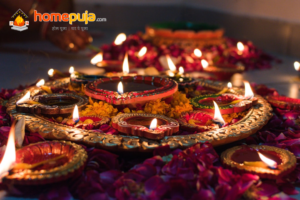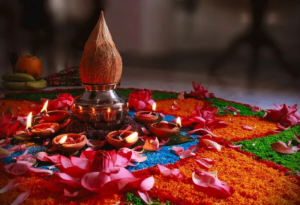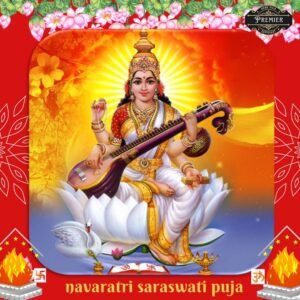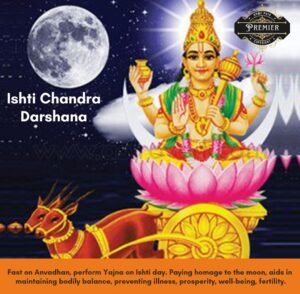
2024 Chaitra Navratri Calendar: Dates, Rituals, and Significance Explained
Chaitra Navratri commemorates Goddess Durga’s birth of the cosmos and all living things within it. Since it is believed that Goddess Durga was tasked with creating the universe, the festival is also widely regarded as marking the beginning of the Hindu calendar year. Chaitra Navratri will be celebrated for nine days, starting on April 9 and concluding on April 17 with the festival of Ram Navami. During these nine days, Hindu devotees will worship the nine forms of Goddess Durga. They are – Maa Shailputri, Maa Brahmacharini, Maa Chandraghanta, Maa Kushmanda, Skanda Mata, Maa Katyayani, Maa Kaalratri, Maa Mahagauri, and Maa Siddhidatri.
Navratri is a significant festival in Hinduism that is celebrated with great enthusiasm and devotion. The word “Navratri” translates to “nine nights”, and it is dedicated to the worship of the divine feminine energy. The festival is observed twice a year, once in the month of Chaitra (March-April) and again in the month of Ashwin (September-October). Chaitra Navratri marks the beginning of the Hindu New Year and is considered highly auspicious.
The first one falls in the month of Chaitra, while the second Navratri falls in the month of Ashwin. The new year for Hindus begins with the Navratri of Chaitra, which we all know by the name of Chaitra Navratri. The same Navratri in the month of Ashwin (October-November) is known as Sharadiya NavratriFirst Navratri Puja of the Year – Chaitra Navratri
- Chaitra Navratri is a nine-day festival dedicated to the worship of Goddess Durga.
- In 2024, Chaitra Navratri will be celebrated from April 9 to April 17.
- Fasting and Performing Puja, Jaap, Paath during Navratri are considered very important and there are specific rituals and customs associated with the festival.
- Navratri celebrations include puja, mantras, music, dance, and traditional vaishnav food and recipes.
Dates of Chaitra Navratri in 2024
In 2024, Chaitra Navratri will be celebrated from April 9th to April 17th. The dates of Navratri vary each year as they are determined by the lunar calendar. It is important for devotees to follow the lunar calendar to ensure that they celebrate Navratri on the correct dates. The festival begins on the first day of the Hindu month of Chaitra and culminates on the ninth day with Ram Navami, the birth anniversary of Lord Rama.
One of the most important rituals of Chaitra Navratri is the Ghatasthapana Puja. It will be observed on April 9. Know muhurat and other details below:
– Ghatasthapana Puja Muhurat: 6:02 am to 10:16 am
– Ghatasthapana Abhijit Muhurat: 11:57 am to 12:48 am
– Pratipada Tithi Start: April 8, 2024, at 11:50 pm
– Pratipada Tithi Ends: April 9, 2024, at 8:30 pm
Chaitra Navratri will be celebrated for nine days, starting on April 9 and concluding on April 17 with the festival of Ram Navami. During these nine days, Hindu devotees will worship the nine forms of Goddess Durga. The nine days of Navratri Puja are as follows:
– April 9 – First Day (Shailputri): Worshiping Maa Shailputri brings strength, health, and success. Symbolic color – Red
– April 10 – Second Day (Brahmacharini): Worshiping Maa Brahmacharini leads to liberation. Symbolic color – Deep Blue
– April 11 – Third Day (Chandraghanta): Worshiping Maa Chandraghanta strengthens luck. Symbolic color – Yellow
– April 12 – Fourth Day (Kushmanda): Worshiping Maa Kushmanda leads to longevity. Symbolic color – Green
– April 13 – Fifth Day (Skandamata): Worshiping Maa Skandamata blesses with offspring. Symbolic color – Gray
– April 14 – Sixth Day (Katyayani): Worshiping Maa Katyayani brings victory over enemies. Symbolic color – Orange
– April 15 – Seventh Day (Mahasaptami – Kalratri): Worshiping Maa Kalratri dispels fear and negativity. Symbolic color – White
– April 16 – Eighth Day (Durga Ashtami — Mahagauri): Worshiping Maa Mahagauri grants desired fruits. Symbolic color – Pink
– April 17 – Ninth Day (Rama Navami – Siddhidatri): Worshiping Maa Siddhidatri grants all accomplishments. Symbolic color – Sky Blue

History and Significance of Chaitra Navratri
Chaitra Navratri has deep mythological roots and is associated with several stories from Hindu scriptures. One popular legend is that during this time, Goddess Durga fought and defeated the buffalo demon Mahishasura, symbolizing the victory of good over evil. Another story tells of Lord Rama’s victory over the demon king Ravana, which is celebrated on the ninth day as Ram Navami.
The significance of worshipping Goddess Durga during Navratri lies in seeking her blessings for strength, prosperity, and protection. She is believed to be the embodiment of Shakti, the divine feminine energy that sustains and nurtures all creation. Devotees offer prayers, perform rituals, and observe fasts to honor the goddess and seek her divine grace.
The Nine Forms of Goddess Durga
The Nine (09) Shakti Forms | |||
Description | Symbolism |
| |
Shailaputri | The daughter of the mountains | Depicted with a trident and lotus flower |
|
Brahmacharini | The one who practices devout austerity | Depicted with a rosary and water pot |
|
Chandraghanta | The one with a half-moon shaped like a bell on her forehead | Depicted with a sword and lotus flower |
|
Kushmanda | The creator of the universe | Depicted with eight arms holding weapons and a rosary |
|
Skandamata | The mother of Skanda (Kartikeya) | Depicted with four arms holding her son and lotus flowers |
|
Katyayani | The daughter of sage Katyayana | Depicted with four arms holding weapons and a lotus flower |
|
Kaalratri | The dark goddess of time and death | Depicted with a sword and noose |
|
Mahagauri | The one with fair complexion | Depicted with four arms holding a trident and drum |
|
Siddhidatri | The giver of supernatural powers | Depicted with four arms holding a lotus flower and mace |
|
During Chaitra Navratri, devotees worship the nine forms of Goddess Durga, also known as Navadurga. Each form represents a different aspect of the goddess and is worshipped on a specific day. The nine forms are Shailaputri, Brahmacharini, Chandraghanta, Kushmanda, Skandamata, Katyayani, Kalaratri, Mahagauri, and Siddhidatri.
Shailaputri is the first form of Durga and is associated with the mountains. Brahmacharini represents the pursuit of knowledge and wisdom. Chandraghanta symbolizes bravery and courage. Kushmanda is believed to be the creator of the universe. Skandamata is the mother of Lord Skanda (Kartikeya). Katyayani is worshipped for marital bliss and protection. Kalaratri is the fierce form of Durga who destroys ignorance and darkness. Mahagauri represents purity and peace. Siddhidatri is the bestower of supernatural powers.
Rituals and Customs of Chaitra Navratri

Chaitra Navratri is a time of intense devotion and spiritual practices. Devotees wake up early in the morning, take a bath, and wear clean clothes before beginning their prayers. They create a sacred space in their homes for the deity by setting up an altar with idols or pictures of Goddess Durga.
The rituals during Navratri include performing aarti (a ritual of waving a lamp in front of the deity), chanting mantras/paath, offering flowers, fruits, and sweets to the goddess, and reciting sacred texts such as the Durga Saptashati. Many devotees observe fasts during Navratri as a way to purify their bodies and minds. Some people choose to abstain from certain foods, while others observe a complete fast for the entire duration of the festival.
Importance of Fasting during Navratri
Fasting is an integral part of Navratri and holds great significance. It is believed that by abstaining from food, devotees can purify their bodies and minds, and focus their energies on spiritual practices. Fasting during Navratri is not just about refraining from eating; it also involves maintaining a pure and positive mindset.
There are different types of fasts observed during Navratri. Some people opt for a strict fast where they consume only water or fruits, while others follow a vrat (fast) where they eat specific foods that are considered pure and sattvic (pure and light). The benefits of fasting during Navratri include detoxification of the body, increased willpower and self-control, and a deeper connection with the divine.
Navratri Puja Vidhi and Mantras
Performing puja (ritual worship) during Navratri requires following a specific set of rituals and reciting mantras. The puja begins with invoking the presence of the deity through the chanting of mantras. Devotees then offer flowers, incense, lamps, and other sacred items to the goddess while reciting prayers.
The mantras chanted during Navratri hold immense power and significance. Some commonly recited mantras include the Durga Chalisa, Durga Saptashati, and the Navarna Mantra (“Om Aim Hreem Kleem Chamundaye Vichche”). These mantras are believed to invoke the blessings of Goddess Durga and bring about positive changes in one’s life.
Navratri Celebrations across India
Navratri is celebrated with great fervor and enthusiasm across different parts of India. In Gujarat and Rajasthan, the festival is marked by vibrant Garba and Dandiya Raas dances, where people come together in large groups to dance in circles, accompanied by traditional music. In West Bengal, Navratri is celebrated as Durga Puja, with elaborate decorations, processions, and cultural performances.
In North India, Ram Navami is celebrated with great enthusiasm, with devotees organizing processions and reciting the Ramayana. In South India, Navratri is celebrated as Golu, where dolls are displayed in homes and women exchange gifts. Each region has its own unique customs and traditions that add to the diversity and richness of Navratri celebrations in India.
Navratri Foods and Recipes
During Navratri, there are certain dietary restrictions followed by those observing fasts. The traditional Navratri diet excludes grains, onions, garlic, and non-vegetarian food. Instead, people consume sattvic foods such as fruits, vegetables, dairy products, nuts, and certain flours like buckwheat and water chestnut flour.
There are numerous delicious recipes that are prepared during Navratri. Some popular dishes include sabudana khichdi (tapioca pearls cooked with spices), kuttu ki puri (buckwheat flour fried bread), samvat rice pulao (barnyard millet pilaf), and makhana kheer (fox nut pudding). These recipes not only cater to the dietary restrictions but also provide essential nutrients and energy during the fasting period.
Navratri Regional Music and Dance
Music and dance play a significant role in Navratri celebrations. The most popular forms of music during this time are Garba and Dandiya Raas. Garba is a traditional dance form from Gujarat that involves circular movements accompanied by rhythmic clapping. Dandiya Raas is a dance form where people use sticks (dandiyas) while dancing in pairs.
The music for Garba and Dandiya Raas is lively and energetic, with traditional instruments like the dhol, tabla, and harmonium being used. The songs are often devotional in nature, praising the goddess and invoking her blessings. The dance forms not only provide entertainment but also serve as a way to express devotion and celebrate the divine energy of Goddess Durga.
Importance of Chaitra Navratri Puja
Chaitra Navratri is a time of immense spiritual significance for Hindus around the world. It is a time to honor and worship the divine feminine energy and seek blessings for strength, prosperity, and protection. The festival is marked by various rituals, fasting, prayers, and cultural celebrations that bring people together in devotion and celebration.
Navratri holds great relevance in modern times as it reminds us of the importance of connecting with our inner divinity and embracing the qualities of love, compassion, and courage. It teaches us to overcome obstacles and face challenges with grace and determination. As we celebrate Chaitra Navratri, let us immerse ourselves in the festivities, deepen our spiritual practices, and embrace the divine energy within us.





















No comment yet, add your voice below!